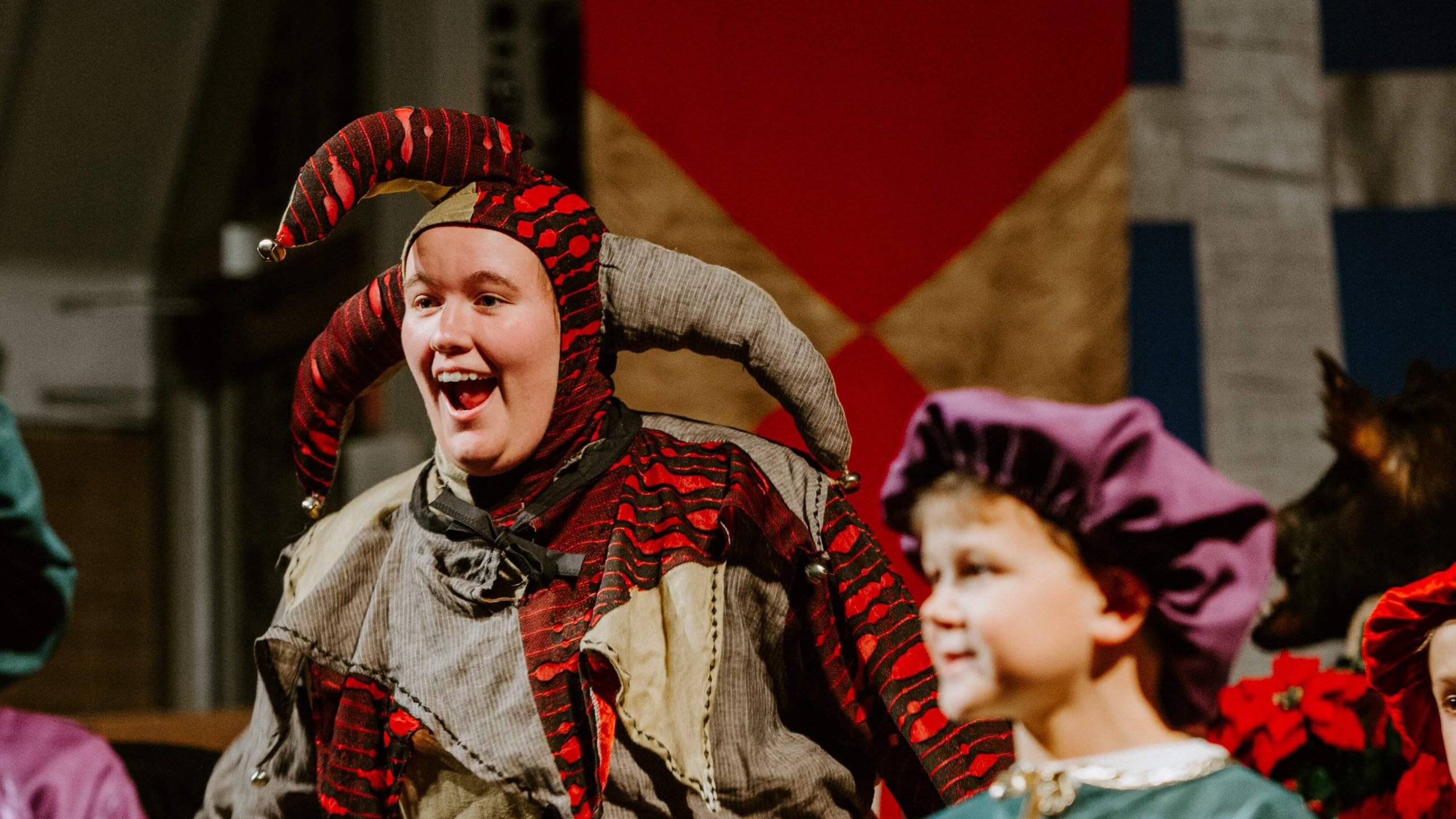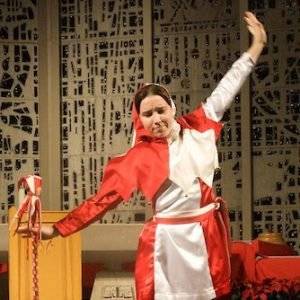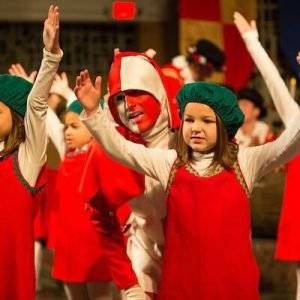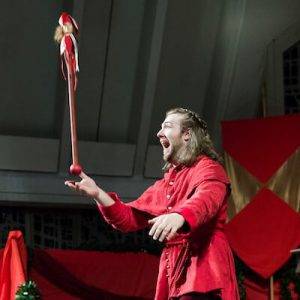
In the Boar's Head Festival's 43-year tradition, there are a few roles that hold reputations of their own. One of those roles? The King's jester.

The Boar’s Head Festival at Concordia University Ann Arbor began in in 1978 through the vision of three Concordia professors—Paul Foelber, John Sturmfels and Quentin Marino. The Boar’s Head Festival has become a treasured memory for many. It remains a vibrant and living tradition as it continues to profess the wonder of the Christmas miracle.
Students, faculty, staff, and members of the community come together to enact medieval Christmas traditions and the story of Christ’s birth in this moving spectacle. One of mainstay roles in medieval times was the King’s jester.

“Last summer, I emailed Boar’s Head producer and theater director Amanda Williams and asked if I could play the role,” said Alex Elliott, who plays the jester in the 2021 Boar’s Head Festival. “The jester is a role that I’ve always dreamed of playing, even since I was a little kid. I think it matches my actual personality well.”
Elliott shared that the jester’s main goal is to act crazy and make people laugh. Throughout the whole show, the objective is to be as funny as they can be.

“I know as a little kid growing up and coming to Boar’s Head, the jester was my favorite character. The jester keeps the production moving and the audience engaged when there’s a little bit of a break in the action,” said Elliott.
In her final year as a student at CUAA, Elliott is fulfilling a a long-time dream playing the jester in this year’s Boar’s Head Festival. She’s been celebrating Christmas by attending CUAA’s Boar’s Head since she was only five years old.
“Everyone who plays the role loves the role,” said Elliott.
Related: Ticket information for the 2021 Boar’s Head Festival, December 3-5
History of The Boar’s Head Festival
By Angela Lai, Sustaining Director
The Boar’s Head Feast was first celebrated about 1340 at Queen’s College, Oxford, England, where it continues to this day. It spread throughout Europe and America, and is held at churches and halls to usher in the Advent season.
“The Boar’s Head Carol” is the oldest printed carol in existence, dating to 1521. Wild boar had the reputation of being savage animals, roaming freely in the forests of Britain, and were often hunted. The 80th Psalm describes Satan as the “wild boar out of the wood”, so his head is carried in triumph, testimony to his final defeat by the newborn King.
The presentation of the boar’s head was a high point of the Christmas feast. The steward brought the head into the great hall on a platter, accompanied by minstrels. Eventually, boar was replaced by beef, goose, or Christmas pie.
A manor house was the residence of a lord. The lord was a tenant of the Crown, whose own tenants worked the land. Manors had great halls, a central gathering point for celebrations and meetings. It was well stocked with servants, who had no financial means to support themselves. The lord was responsible for the local village, farmland and woods. The lord’s wife held the title of “Lady”. She was responsible for taking care of the house and bearing children. Ladies had no rights and owned no property. They were considered property themselves, owned by their fathers, husbands, and even their oldest sons. Some had personal female assistants, known as ladies-in-waiting.
In the festive season, the manor house was kept open for guests. The hall would be decorated, and long tables put in place for visitors who were strictly segregated by rank.
Food served at Christmas banquets was varied. The average dinner could consist of three or four courses, but for royalty it was seven. In England, not only was boar on the menu, but swan, peacock, turkey, venison, rabbit, fish, fruit, nuts, pastries, wine and spirits.
Heralds, Beefeaters, Waits, Wassail, Yule Log, Jester, and more
Heralds were ambassadors sent by monarchs or nobles to convey a message or deliver a proclamation. The herald would wear a tabbard, decorated with a coat of arms belonging to his master.
Beefeaters were created in 1485 to serve as the official bodyguards of the monarch. They would carry banners which bore the colors and symbols of the reigning king. Their halberd was a two handed pole weapon resembling an axe.
Waits were not children, but watchmen at castles and towns, where d1ey patrolled. They were given instruments similar to the oboe to sound the alarm. Around Christmas, they would rouse sleepers with religious songs. They also performed for civic ceremonies.
Wassail consisted of a blend of strong ale, cloves, eggs, toasted bread, sugar, cream, almonds and spices. Wassailers were young people who traveled the countryside carrying a bowl of wassail, offering it to the inhabitants. Wassailers would sing songs, toasting the holiday season.
The Yule Log was a tree, stripped and dried, burnt on a large open fire, providing warmth against the bitter cold. It was often brought home with considerable ceremony, drawn with ropes by many willing hands.
King Wenceslas was not a born king, but a duke who was posthumously elevated in rank. He was raised a pious Christian by his grandmother. He encouraged the work of missionaries throughout Bohemia and was martyred at age 22 by his younger brother. The song “Good King Wenceslas” was written by John Neale, in 1853, set to the rune of a thirteenth century carol.
In the British Isles, belief in fairies and sprites dates from the twelfth century. They were known for benevolence and emanating light. The Yule Sprite shares elements with the Christ kind, a divine child who over time has morphed into a magical, angelic spirit, its presence known only by the sound of a tinkling bell. The Christ kind was introduced by Martin Luther, intended to be a representation of the Christ child.
The king’s jester was a mainstay in Europe. He might be a university dropout, a former monk, a minstrel with an exceptional sense of humor, or a clever apprentice. They found employment at court or would wander from village to village. Entertainments included juggling, singing, acrobatics, jokes, and magic tricks. They would often carry a marotte, a stick with a miniature carved head, used for twirling, tossing, or teasing members of the audience.
The image of a knight is familiar through legend and literature. In reality, they were fierce warriors who were associated with the medieval code of chivalry. The Knight here has slain the boar, an allegorical representation of the Christian soldier who fights spiritual battles, not physical ones.
The Christmas story
The Christmas Story needs no introduction. Plays that dramatized sections from the Bible were popular during the Middle Ages, and were called mystery plays. Our excerpt begins with the journey of Mary and Joseph to the inn, and culminates with the adoration of the three Kings. Angels often appear in mystery plays, wearing white, combining notions of grace and beauty. Angels often dance in religious drama, representative of their non-corporeal nature and ability to transcend space and time.
Boar’s Head Festival
Stay up to date on the Concordia University Ann Arbor Boar’s Head Festival at cuaa.edu/boarshead.
— Rachel Thoms served on Concordia University's Strategic Communications team from 2015-2022. Any inquiries about this story can be sent to news@cuaa.edu.
If this story has inspired you, why not explore how you can help further Concordia's mission through giving.